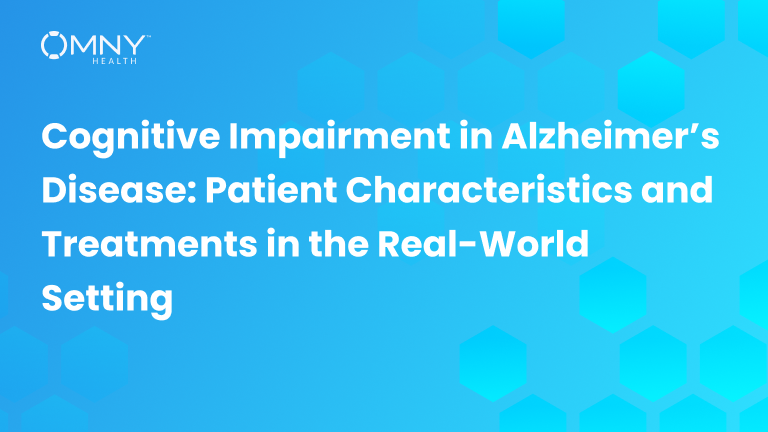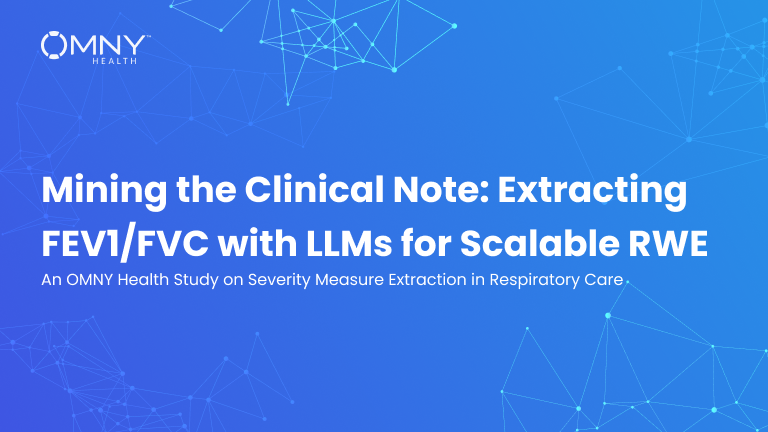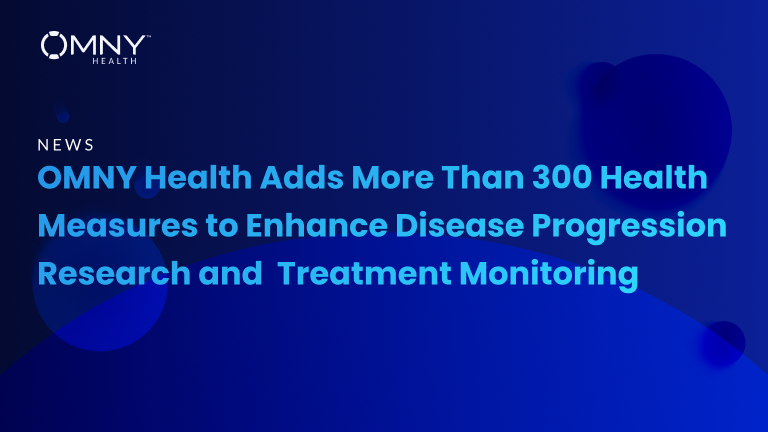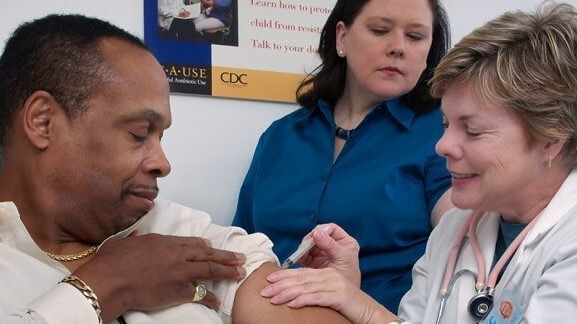HEOR at the Nexus of Policy and Science
OMNY Health believes in the importance of a truly transparent, secure, and connected real-world data (RWD) ecosystem to accelerate life-changing care and treatment innovation between providers, patients, and life science companies.
Comprehensive, representational de-identified data, standardized and aggregated from the complete EHR record can generate health economics and outcomes research that is truly – like the focus of this year’s ISPOR Europe – at the center of policy and science.
ISPOR Europe was an amazing event this year. There were many common themes among the presentations at the conference, including the harmonization of European data practices and RWD collection and standardization. Other presentations focused on the use of RWD to generate real-world evidence, health technology assessment regulations, and the creation of external clinical trial control arms. Other speakers spoke to the need for RWD-informed policy and science.
HEOR Only as Strong as the Data Behind the Analyses
OMNY Health presented five posters at this year’s ISPOR Europe conference. These posters all focused on using RWD to generate real-world evidence around a variety of topics, including long-term COVID-19, social determinants of health (SDoH), and dermatological diseases. For each poster, OMNY Health scientists utilized the rich EHR data assets in our OMNY Health Platform™ to power new and accurate evidence for the clinical studies presented.
The following is a summary of the purpose and findings of each poster.
1) Long COVID: Clinical Characteristics and Management in the Real-World Setting
A total of 17,542 people with long COVID were studied using OMNY Health data to understand the demographics, concurrent diagnoses, and treatment patterns for those with a long COVID-19 diagnosis code (ICD-10-CM: U09.9). Data were studied from the period of 2021 to June 2023 from four integrated delivery networks and one children’s hospital. Ongoing breathing abnormalities and cough were the most common concurrent diagnoses accounting for 43% of people with long COVID in the study. An analysis of prescription drugs and procedures for these people found that asthma and chronic obstructive pulmonary disease drug treatments were the most common therapies given (25%) with antibacterial agents being the second (13%). The top surgical treatment procedure was radiological at 34%.
This analysis demonstrated how EHR data can be leveraged as a valuable tool to provide insights into chronic disease, clinical characteristics, and disease progression.
2) Identifying economic insecurity among psoriasis patients using natural language processing and unstructured clinical notes
Clinical codes for social determinants of health, such as economic insecurity, exist in the International Classification of Diseases, Tenth Revision, but are often underutilized in clinical practice. This often results in a lack of structured SDoH data recorded in clinical records. However, this type of information can also be found in unstructured data such as clinical notes. The objective of this study was to train and apply a natural language processing model (NLP) to extract economic insecurity information from clinical notes and compare its results identifying economic insecurity from structured clinical coding.
A total of 2,007 clinical note sentences were sampled and annotated to train the model. When the model was applied to almost 51,000 people with psoriasis, 686 people were positive for economic insecurity as opposed to zero people having recorded ICD-10 clinical codes for economic insecurity. Of the 100 positive sentences checked for accuracy, sixty percent were true positives.
This study indicates that NLP can be a useful tool to identify SDoH from the unstructured portions of clinical patient records among patients lacking SDoH ICD-10 codes.
3) Trends in the therapeutic management of bullous pemphigoid in the real-world setting
Bullous pemphigoid (BP) is an autoimmune disorder, often found in the elderly, that causes blisters on the skin. The prevalence of BP is increasing in the US and treatments for BP, including corticosteroids, are associated with toxicities and disease recurrence over time. OMNY Health researchers created a profile of real-world BP treatment patterns across diverse treatment settings in the United States to inform the development of future treatments. They did this by accessing electronic health record data from six multi-state specialty dermatology networks and four integrated delivery networks from 2017 to 2023.
Demographics and disease severity at first BP diagnosis were collected along with the percentages of people with prescriptions for topical corticosteroids (TC), systemic corticosteroids (SC), non-immunosuppressive agents, and immunosuppressants.
- TC prescriptions were the most widely used, increasing from 53% in 2017 to 72% in 2023, peaking at 76% in 2022.
- SC use ranged from 29% to 41%, peaking in 2021.
- Non-immunosuppressive agents increased from 30% in 2017 to 35% in 2023, peaking at 37% in 2022.
- Immunosuppressants were the least used, ranging from 12% to 16%.
These results provided insights into the real-world treatment patterns over time for those with BP. As new treatments are introduced similar analyses could provide insights into uptake and prescription patterns among BP patients at different severity stages.
4) Real-world treatment patterns of ankylosing spondylitis
Ankylosing spondylitis (AS) is an inflammatory disease, affecting the spine, which often spreads to the joints between vertebrae. This disease, which often worsens with age, has treatments that focus on relieving the symptoms of pain and inflammation and preventing longer-term complications. This study examined the real-world treatment patterns of people with AS. These treatments include analgesics and opioids, tumor necrosis factor (TNF) alpha inhibitors, anti-inflammatories, and interleukin 17 (IL-17) inhibitors. Electronic health record data from the OMNY Health RWD platform was accessed for 6,171 people with AS across integrated delivery networks and specialty clinics. Demographic data and the percent of visits with prescriptions were tracked for 5.5 years. Analgesics/opioids were prescribed at 16% of AS-associated patient visits, while TNF alpha inhibitors and IL-17 inhibitors were prescribed at 5% and 1% of AS encounters, respectively.
This study indicates that the long-term electronic health record data found in the OMNY Health RWD platform can be used to provide insights into the therapeutic management of a relatively rare disease such as AS.
5) Itch intensity and therapeutic management of pruritus in the real-world setting
Pruritus, itchy skin, is a cutaneous symptom that presents in a variety of clinical systemic conditions. Its ubiquitous nature is challenging to treat and can greatly impact the lives of those people who have pruritus. Itch intensity scores (1-10) are often documented, especially in dermatological clinics, as a measure of symptom severity. These scores inform pruritus treatment and management.
This study examined the relationship of itch intensity with therapeutic management choices for people with pruritus in six dermatology networks from 2017 to 2013. A total of 7,330 people with pruritus and a recorded 10-point itch intensity assessment associated with a pruritus diagnosis code were studied in the OMNY real-world data platform.
Topical therapies were prescribed at approximately half of pruritus visits, regardless of itch intensity, with topical corticosteroids prescribed at approximately 45% of those visits. Systemic therapy prescriptions were more likely to vary dependent upon itch intensity with 32% of prescriptions associated with the highest itch intensity of 8-10.
This study indicates that the rich dermatological data sets in the OMNY Health RWD platform can be used to provide insights into the management of disease symptoms that greatly impact the quality of life for those who have them.
OMNY Health’s Powerful RWD Platform Informing HEOR and the Impact of SDoH
The 2023 ISPOR Europe conference was an invigorating experience focused on discourse about the changing research landscape in Europe, HEOR, and RWD in the life sciences industry.
OMNY Health values the interactions we had and the opportunities to showcase the strength of our real-world data platform in providing the types of insights that life sciences companies and policymakers seek to understand diseases, treatment patterns, and the impact of disease on the people who have them.






